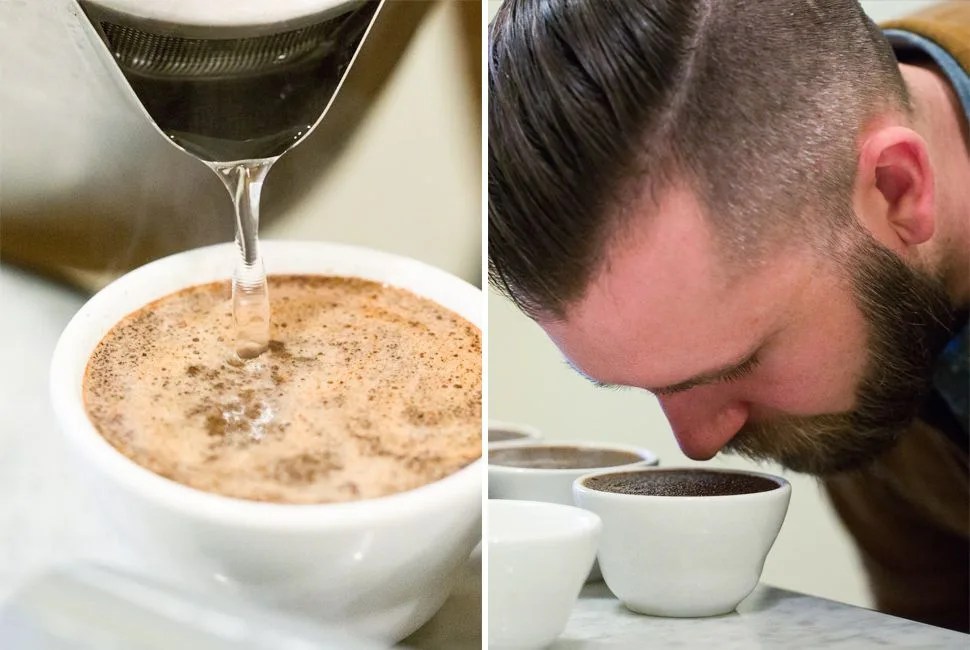12 photos
The sophistication of your daily dose of caffeine, according to Jonathan Withers, is vastly underestimated. “Coffee is such a complex piece of fruit that we’re doing a tremendous amount of work to, any facet of which makes huge to small ramifications in the cup,” says Withers, who’s young, careful with his words, and perfectly coiffed. As the green buyer at Toby’s Estate Williamsburg, Brooklyn flagship coffee shop, Withers fulfills the oft-romanticized duty of traveling the world to source and buy the company’s small-batch coffee. Now, in the shop’s backroom, he’s using a large, framed illustration of the coffee shrub to prove his point. “The species of plant… where it’s grown, what elevation, how it’s watered, fertilized… fermentation, storage, transportation. It’s endlessly fascinating to think about everything that’s been involved. And that’s just to get the beans in the door.”
Through the cupping room’s window I can see what happens once the beans make their entrance. Human-sized bags of them slump against the walls. In the corner, a giant Probat P25 machine’s farm-implement-like blades revolve, cooling their daily load of 2,000 pounds of roasted beans for 150 accounts in the city. Beautiful twentysomethings order pour overs and espressos from the counter and return to benched tables to convert plant-based caffeine into man-hours.
Roasting, grinding, brewing and sipping: these are the known quantities of a coffee roaster, to the masses. What goes on in this small room at the back of the shop, a ritualized tasting called a coffee cupping, is less known, but more important to understanding how a coffee cherry becomes a cup of coffee, and the tastes and smells that journey eventually imparts. If the sum of a drink’s parts can become something more — a “soul,” for the indulgent — then cupping is a trip to worship at a half-reverential, half-raucous church of the bean.

For Withers and Allie Caran, though, cupping is also a routine duty. Caran, a coffee educator at the company’s Brew School, uses the altered brewing format and ritualized tasting style as an opportunity to teach about coffee’s many and varied sensory profiles; Withers cups the previous day’s roasts every morning at 7 a.m. as a form of quality control, and uses cupping notes as a standardized way to communicate with growers and producers of the raw, “green” product. For both, cupping is about taking on coffee as a serious beverage (and an enormously profitable business) rather than a treat. “You need this format to experience it,” Withers says. “Versus having a cup of coffee, where, yes, you’ll just sit there and experience that same gradient of flavors, but — I might not be distracted, exactly, but I’m sitting there, enjoying my life.”
Of the adult beverages currently in vogue — coffee, craft beer, wine and whiskey — coffee seems to lag behind in tasting comprehension. (That’s in spite of the fact that Americans in 2014 drank on average more than three cups of “specialty coffee” — coffee sold by businesses largely dedicated to selling only coffee — per day, according to the National Coffee Association annual trends study.) Yes, the average drinker is far from illiterate in recognizing “good” coffee — Starbucks took the lead in quality coffee’s increased role in what is today a $48 billion coffee industry in America, and smaller, more boutique roasters like Toby’s continue to wage a coffee revolution in urban centers from Portland to Brooklyn. But for regular drinkers, discerning distinct tasting notes remains elusive.













